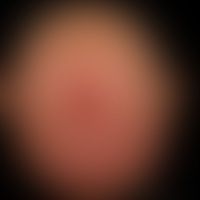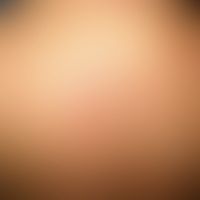Image diagnoses for "red"
901 results with 4543 images
Results forred

Granuloma anulare (overview) L92.-
Granuloma anulare, classic type . borderline, in the centre skin-coloured, smooth, painless, firm papules and plaques with the formation of an indicated ring shape without scaling over the middle joint of the left middle finger.

Lupus erythematosus systemic M32.9
Systemic lupus erythematosus: Detailed view of the protruding follicular structure in the area of the lesional plaques.

Venous leg ulcer I83.0

Cutaneous t-cell lymphomas C84.8
lymphoma, cutaneous t-cell lymphoma. type mycosis fungoides, tumor stage. painless, scaly, partly crusty plaque existing for years with slow knot formation and increasing growth rate. moderately firm consistency. extensive crust formation.

Stevens-johnson syndrome L51.1
Stevens-Johnson syndrome: Acutely occurring vesicular exanthema with characteristic, bull's-eye erythema, plaques and blisters as well as extensive, painful erosions of red lips, lip mucosa, tongue and gingiva in an 18-year-old woman. Clear general feeling of illness.

Atopic dermatitis in children and adolescents L20.8
eczema atopic in childhood: 14-year-old adolescent with generalized atopic eczema. striking grey-brown, dry skin. multiple scratched papules and plaques. extensive, therapy-resistant pyoderma on the left thigh (developed after traumatic abrasion)

Psoriasis palmaris et plantaris (plaque type) L40.3
Psoriasis palmaris et plantaris (plaque-type chronic inpatient plaquepsoriasis of the sole of the foot with coarse desquamation and painful hare formation. no topical pre-treatment

Vasculitis leukocytoclastic (non-iga-associated) D69.0; M31.0
Vasculitis leukocytoclastic (non-IgA-associated): multiple, since 1 week existing, on both legs symmetrically localized, irregularly distributed, 0.1-0.2 cm large, confluent in places, symptomless, red, smooth spots (not compressible).

Psoriasis vulgaris L40.00
Psoriasis vulgaris. general view: multiple, solitary or confluent, nummular or large-area, erythrosquamous plaques on the buttocks of a 49-year-old woman with psoriasis vulgaris existing since adolescence. the skin lesions continue into the rima ani.

Squamous cell carcinoma of the skin C44.-
Squamous cell carcinoma in actinically damaged skin: Since more than 1 year, slowly growing, very firm, little pain-sensitive, ulcerated node, which (at the time of examination) was no longer movable on its base. Pronounced field carcinoma .

Atopic dermatitis in infancy L20.8
Superinfected atopic dermatitis:chronic pyodermic eczema in an infant

Cherry angioma D18.01
Angioma, senile. multipe, chronically stationary,1-4 mm large, sharply defined, initially light red, later dark red to violet, soft, flat papules. patient reported severe seborrhea on the integument.

Lupus erythematodes chronicus discoides L93.0
lupus erythematodes chronicus discoides: 35-year-old otherwise healthy patient. skin lesions since 12 months, gradually increasing, no photosensitivity. multiple, chronically stationary, touch-sensitive, red, plaques with central adherent scaling. histology and DIF are typical for erythematodes. ANA and ENA were negative.

Striae cutis distensae L90.6
Striae cutis distensae: Fresh (red), symmetrical striae after many years of internal and local (steroid inhalation) therapy with glucocorticoids for bronchial asthma.

Hand-foot-mouth disease B08.4
Hand-foot-mouth disease, painful 0.3 cm large erythema, papules, aggregated blisters as well as extensive skin detachment on the toes after previous blister formation.

Anal dermatitis (overview) L30.8
eczema, anal eczema. uniform, perianal localized, partly erosive-wetting, blurred, smooth redness. severe, persistent itching.

Intertriginous psoriasis L40.84
Psoriasis intertriginosa: inversely localised psoriasis with sharply defined red plaques and firmly adhering, shield-like scaly deposits.
Remark: in this case systemic therapy with fumaric acid ester is recommended.







